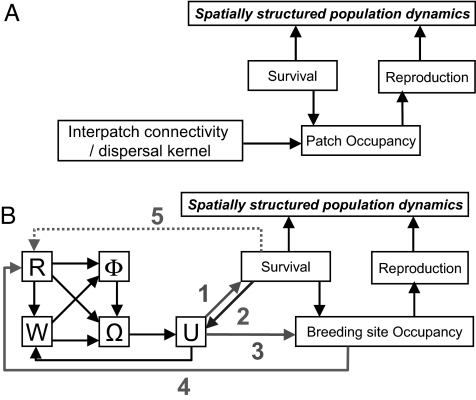Fig. 1.
Schematic representation of the processes involved in the dynamics of spatially structured populations. (A) Patch-centered view where survival and reproduction are considered as local processes. Between-patch processes (namely movement) are represented by a matrix of interpatch connectivities, commonly based on distance kernels (different survival regimes during interpatch processes act as modifiers of the complete kernel). (B) Individual centered representation, including the movement process of dispersing individuals in search of empty breeding sites (natal dispersal) as described within the movement-ecology framework. W, the internal state of the individuals motivating the movement; Ω, motion capacity; Φ, navigation capacity; R, external environmental conditions that can affect the internal state and the navigation and motion capacities; U, actual movement path followed by the individual. Numbered arrows represent the dynamic interaction of movement with demographic processes. Arrow 1, the actual path affects the survival (spatially heterogeneous, e.g., inside and outside a reserve); arrow 2, the actual survival of moving individuals affects the time moving and hence the length of the path; arrow 3, moving individuals settle in empty breeding sites, thus dynamically modifying the pattern of empty sites (which are dynamically generated); arrow 4, the pattern of empty sites is an external environmental modifier of the movement (potential targets); arrow 5, individuals perceive and respond to a differential risk of mortality associated with the presence of a fragmented matrix (the perceived risk depends on animal's position).

